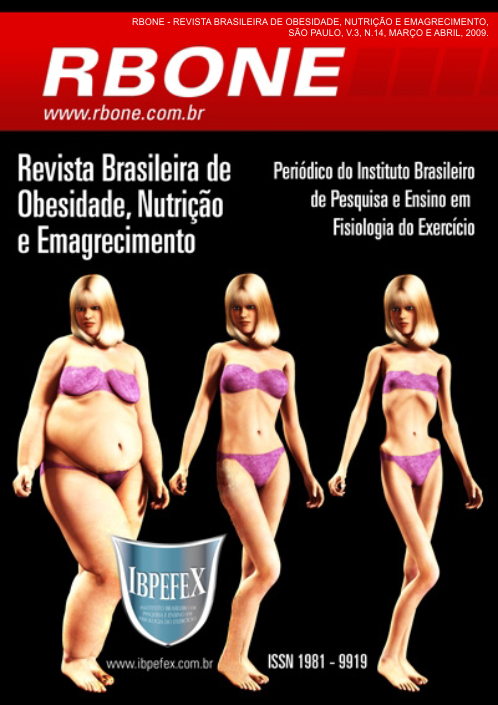Childhood Obesity: The school and the family must be aware of
Abstract
Objectives: The objective of this research was to monitor, during 3 years, the variation (increase and/or decrease) of the body mass index (BMI) of the students of a school, in Salvador/BA, and evaluate the answer of the family to the parents’ orientation service, about child obesity, offered by the school. Tools and Method: Annual gauging of the students’ weight (kg) and height (m) in order to calculate the Body Mass Index (BMI). The development of a multisubject content in the classroom about health, the control of the canteen by the students and meeting with the parents of the children in risk for orientation about control and treatment of the obesity. Results: The total prevalence of overweight was superior to the obesity among students. The overweight average over the three years among males was 16%, and among females was 22.33%. The obesity reached, along the three years the average of 2.66% among males and 3.66% among females. Only 7.5% of the parents of the students in a risk situation looked for the service of orientation offered by the school along the three years of the research. In this group of parents it was observed a high level of misinformation about the obesity and its consequences to the child's health. Conclusion: The reduction of the levels of overweight and obesity in the sample studied shows a positive influence of the school, nevertheless, the fact that the parents did not involve themselves did not optimize the results. Thus, we can conclude that the school and the family have a strong influence in the overweight situation among students.
References
- Barbosa, V.L.P. Prevenção da obesidade na infância e na adolescência: exercício, nutrição e psicologia. Baurueri-SP: Manole, 2004.
- Bouchard, C. Atividade física e obesidade. Baurueri-SP: Manole, 2003.
- Cole, T.J.; Bellizzi, M.C.; Flegal, K.M.; Dietz, W.H. Establishing a standard definition for child overweight and obesity worldwide: international survey. British Medical Journal. Num. 320. 2000. p. 1240.
- Coutinho, W. Etiologia da obesidade. Órgão Informativo da Associação Brasileira para o Estudo da Obesidade e da Síndrome Metabólica. Ano VII – número 30, maio de 2007.
- Foreyt, J.; Goodrick, G. The ultimate triumph of obesity. Lancet. Vol. 346. Num. 8968. 1995. p. 134-135.
- Gortmaker, S.L.; Must, A.; Perrin, J.M.; Sobol, A.M.; Dietz, W.H. Social and Economic Consequences of Overweight in Adolescence and Young Adulthood. Vol. 329. Num. 14. 1993. p. 1008-1012.
- Guerra, I. Nutrição e atividade física no tratamento da obesidade infantil. Revista Nutrição em Pauta. São Paulo. Ano 16. jan/fev, 2008. p. 36-39.
- Hill, J.O.; Peters, J.C. Environmental contributions to the obesity epidemic. Science. Vol. 280. Num. 5368. 1998. p. 1371-1374.
- Menestrina, E. Educação física e saúde. 2ª ed. rev. ampl. Ijuí: Uijuí, 2000. 112 p.– (Coleção educação).
- Oliveira, A.M.A.; Cerqueira, E. de M.M.; Oliveira. A.C. Prevalência de sobrepeso e obesidade infantil na cidade de Feira de Santana-BA: detecção na família x diagnóstico clínico. Jornal de Pediatria. Vol. 79. Num. 4. 2003. p. 325-328.
- Silva, J.A.; Miranda Neto, J.T.; Raposo, J.J.V.; Carvalhal, M.I.M. Obesidade infantil. Montes Claros: CGB Artes Gráficas, 2007. 188 p.
- Strauss, R.S. Childhood Obesity and Self-Esteem. Pediatrics. Vol. 105. Num.1. 2000. p. 1-5.
- Vilar, A.P.F.; Valverde, M.A.; Fisberg, M.; Lemes, S.O. Uma medida de peso. São Paulo: Celebris, 2002.
Authors who publish in this journal agree to the following terms:
- Authors retain the copyright and grant the journal the right of first publication, with work simultaneously licensed under the Creative Commons Attribution License BY-NC which allows the sharing of the work with acknowledgment of the authorship of the work and initial publication in this journal.
- Authors are authorized to enter into additional contracts separately for non-exclusive distribution of the version of the work published in this journal (eg, publishing in institutional repository or book chapter), with acknowledgment of authorship and initial publication in this journal.
- Authors are allowed and encouraged to post and distribute their work online (eg, in institutional repositories or on their personal page) at any point before or during the editorial process, as this can bring about productive change as well as increase impact and impact. citation of published work (See The Effect of Free Access).






